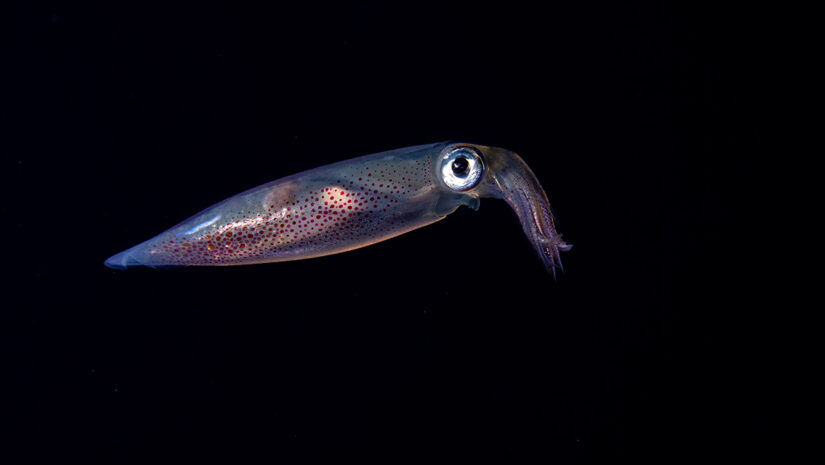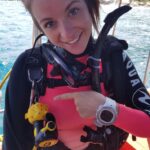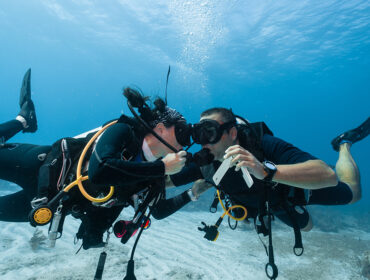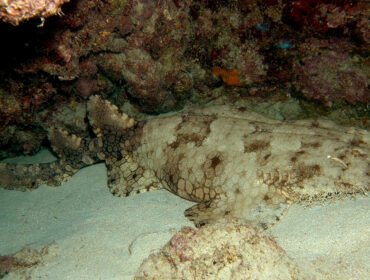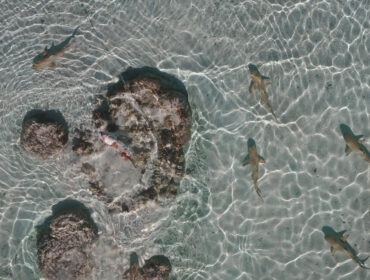Blackwater diving takes you away from the reef and into the open ocean at night. Suspended in the dark, with no seafloor beneath you, you watch as strange deep-sea creatures rise toward the light.
It’s thrilling, visually stunning, and unlike any other dive, but it also raises questions. How deep do you go? Is it safe? What should you expect?
In this guide, we’ll break down what blackwater diving is, how to prepare, and what makes it both a challenge and a highlight for experienced divers.
What is Blackwater Diving?
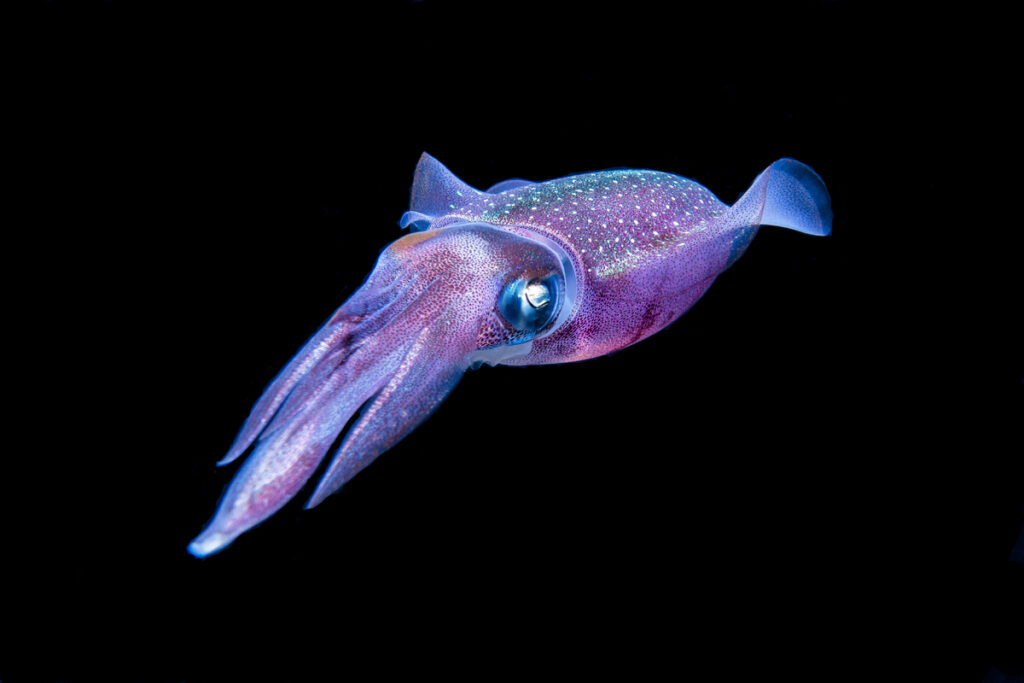
Blackwater diving is a night dive that takes place in the open ocean, suspends divers midwater, and reveals deep-sea life that rises after dark.
Instead of exploring reefs or sandy bottoms, divers are dropped offshore, usually over hundreds or thousands of feet of water. With no visible seafloor, they hover in the water column, waiting for ocean creatures to appear.
Floodlights are lowered from the boat to attract migrating life, tiny larval fish, comb jellies, salps, and other translucent organisms that rise from the deep in one of the ocean’s largest daily events.
Most divers are clipped to a tether line beneath the boat. Some swim freely around the lights, but this is only recommended for those with prior blackwater experience. Orientation is limited to the beam of your torch, and staying close to the boat is key.
Blackwater dives usually stay shallow, around 30 to 60 feet, but take place over deep, open water. The dive feels vast and bottomless, with no fixed reference points. For photographers and curious divers, it offers the rare chance to witness life that few ever see.
Choose a dive light rated at 1,000+ lumens, like the Blue Reef 1200 Lumens or Mares EOS series, to cut through the water column and attract distant plankton.
Why Divers Love It & What Creatures You’ll See
Blackwater diving reveals larval creatures, deep-sea drifters, and translucent animals rarely seen during the day.
At night, marine life rises from the depths in search of food. This vertical migration brings small, alien-like organisms into the shallows, right where divers are suspended in the water column.
Common sightings include salps, comb jellies, jellyfish, pelagic tunicates, crustacean larvae, and juvenile fish. Many are transparent or bioluminescent, appearing only as faint outlines until they drift into a beam of light. Some divers report rare finds like paper nautilus or blanket octopus, though these are unpredictable.
Divers don’t chase the creatures. Instead, they wait. With a steady torch and neutral buoyancy, life comes to them. The less movement in the water, the more likely these animals are to linger.
For photographers, blackwater diving offers a unique canvas. There is no reef, no background clutter, and no competition for light. Just a clean, black backdrop and subjects that glow, pulse, or drift in the current. The results are some of the most surreal underwater images in diving.
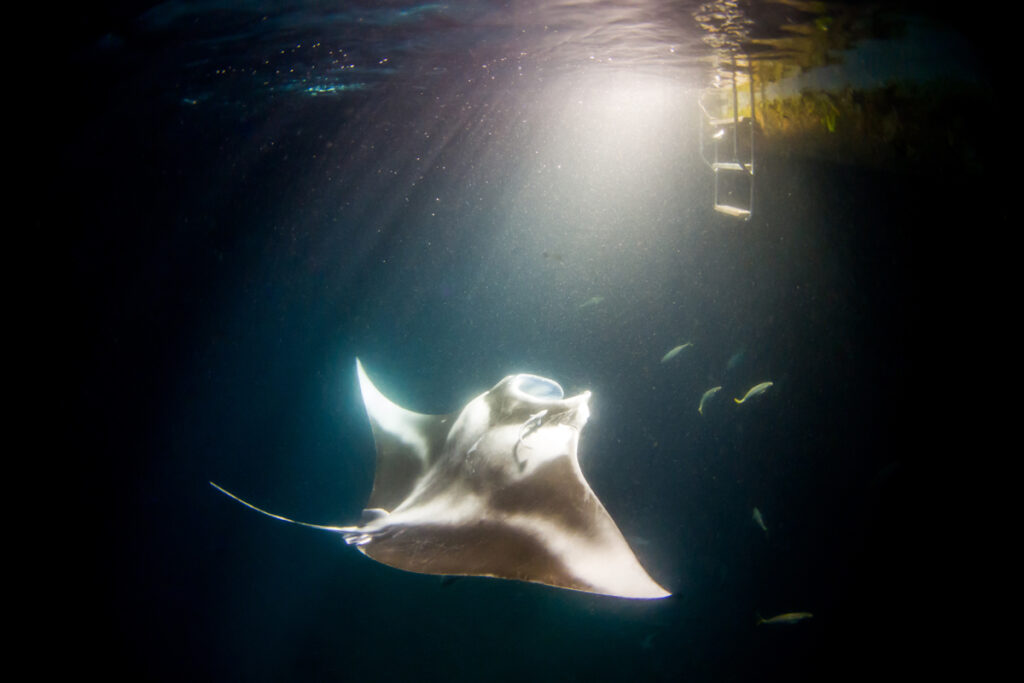
Blackwater Diving vs Night Diving
Blackwater diving happens in open water, lacks a solid reference point, and focuses on drifting life instead of the reef.
While both are done after dark, blackwater diving and traditional night diving offer very different experiences. Here’s a quick look at the key differences between blackwater and night diving:
| Feature | Night Diving | Blackwater Diving |
| Location | Reef, wreck, or shore-based | Open ocean, far from shore |
| Depth Range | Usually 10–60 feet | Typically 30–60 feet (over deep water) |
| Environment | Follows a fixed bottom or structure | No bottom reference, open water column |
| Navigation | Visual reference from reef or slope | Tethered line or visual orientation only |
| Marine Life | Nocturnal reef creatures | Larval fish, jellies, pelagic drifters |
| Light Use | Torch to scan terrain | Floodlights attract life from below |
| Orientation | Guided by terrain | Guided by buoyancy and lights only |
| Dive Objective | Explore reef activity at night | Observe planktonic migration and rare life |
| Skill Requirements | Good torch skills, basic night awareness | Strong buoyancy, low-light confidence |
| Photographic Appeal | Close-up reef behavior | Surreal macro on a black backdrop |
Night diving usually takes place over a reef, wreck, or sandy bottom, where divers follow a set route using torches to spot nocturnal marine life hiding in crevices or patrolling the substrate.
Blackwater diving removes the bottom entirely. Instead of following terrain, divers hover in the midwater column, often over extreme depths, watching as pelagic animals rise from the deep. The feeling is more like floating in space than moving along a dive site.
Stay close to the descent line. Orientation is limited at night, so keeping a fixed visual reference helps you stay calm and aware.
In night diving, the reef or slope helps orient the diver. In blackwater diving, orientation comes from a tether line, a torch beam, or the faint glow of a boat light above. For first-time blackwater divers, this lack of a visual anchor can feel disorienting at first.
The skillsets overlap, but blackwater requires stronger buoyancy control and comfort in featureless environments. A diver used to scanning cracks and coral heads must learn to slow down and watch the water itself. The animals appear suddenly and drift past without warning. It’s a completely different mindset.
Many blackwater operators require night diving certification before booking a trip. For divers who love the quiet focus of night dives and want to see marine life few others ever encounter, blackwater is a natural next step.
Preparing for Blackwater Diving
Blackwater diving requires strong buoyancy, clear focus, and a specific gear setup.
It’s not an activity for beginners, and it’s important to have the appropriate training, dive gear, and preparation.
Training and Experience
Although ultimately there’s no specific training required, it’s important to have experience and be comfortable in low-light, open ocean conditions.
Many operators require the following training before allowing you to blackwater dive:
- Night diving certification is typically required
- Have at least 50 dives under your belt
- Advanced Open Water certification is recommended
- Experience with drift or deep dives is useful
- Divers should have strong buoyancy and situational awareness
- Familiarity with torch use and buddy separation procedures is essential
- First-time blackwater divers should begin with tethered dives over guided reef night dives
Mental Preparation and Buoyancy Control
There’s no reef, no slope, and no bottom, just water, current, and light. Staying calm and aware is key. Good buoyancy control helps you avoid sudden depth changes and keeps you stable in the water column.
Here are some tips for staying mentally prepared for blackwater diving:
- Practice midwater hovering before your dive trip
- Use slow, deliberate finning to stay neutrally buoyant
- Focus on steady breathing to stay calm and reduce vertical drift
- Stay close to the descent line or tether at all times
- Avoid sudden depth changes or chasing creatures
- If you feel disoriented, stop, breathe, and reorient using your light or the boat
Essential Gear Checklist
Most operators will provide you with torches. Other than that, it’s what you’d usually take out on a dive.
But here are some of the equipment you’ll certainly need for a blackwater dive trip:
- Primary torch: High-lumen, wide-angle beam (handheld or mounted)
- Backup torch: Clipped securely to your harness or BCD
- Lanyards or bolt snaps: To prevent gear loss or drift
- Surface marker buoy (SMB) and spool: For safety and surface visibility
- Dive computer or wrist compass: For tracking depth and time in low visibility
- Trim weights or ankle weights: Optional, to fine-tune body position
- Underwater camera setup: Optional, with focus light and macro lens for small subjects
Check all equipment before the dive. A gear failure at night, offshore, can end your dive early and compromise safety.
Best Places To Try Blackwater Diving
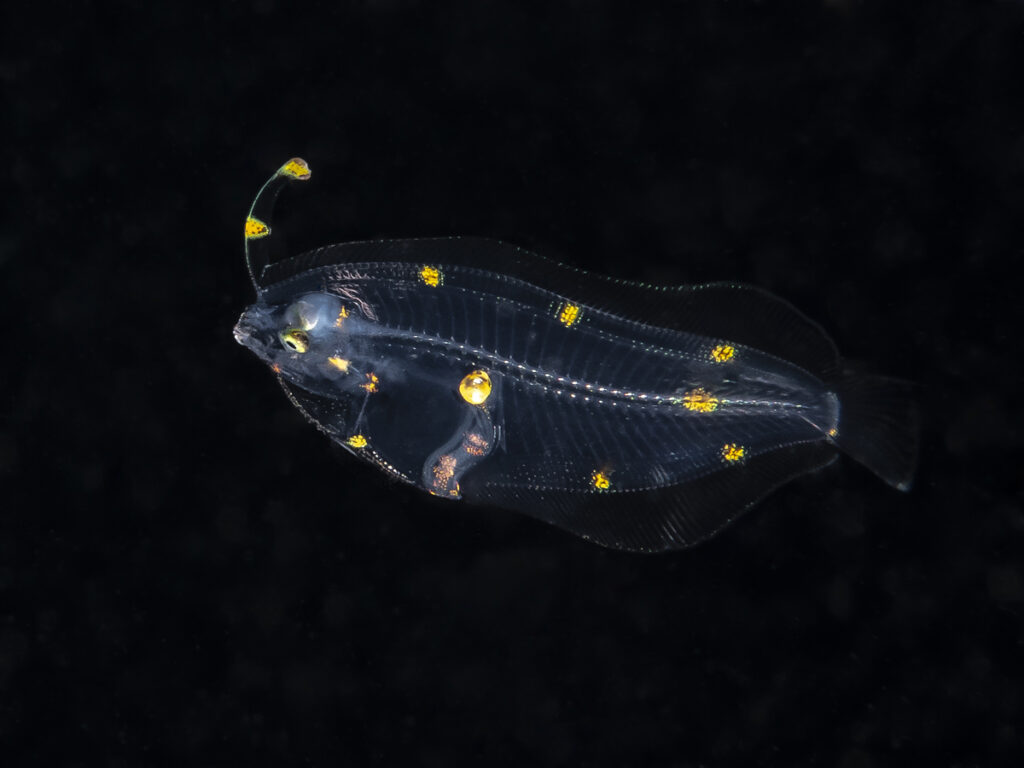
Blackwater diving works best in places where the drop-offs are steep, the water is warm, and the marine life is wild and unpredictable.
While many coastlines offer night diving, only a handful consistently deliver the conditions needed for blackwater. These spots have deep water near shore, minimal swell, and dive operators experienced in handling the lighting, lines, and logistics.
Kona, Hawaii
Kona is where recreational blackwater diving began. Local operators started experimenting with floodlights in the 1990s, and today it remains the most established destination in the world for this type of dive. Blackwater tours here run almost every night, with dozens of operators offering regular trips just minutes from shore. There are also plenty of other sought-after Hawaii trips, including scuba diving in Maui.
- Depth of the dive: 40 to 60 feet, tethered over drop-offs exceeding 1,000 feet
- Typical sightings: Paper nautilus, comb jellies, larval eels, ctenophores, salps
- Best time to go: Year-round, with peak conditions from June to September
Anilao, Philippines
Famous for muck and macro photography, Anilao also hosts vibrant blackwater dives. Most are launched from small boats just offshore, with water clarity and calm seas providing excellent shooting conditions for both beginners and pros. Several resorts now include blackwater as part of multi-dive day packages.
- Depth of the dive: 40 to 50 feet, in relatively calm offshore conditions
- Typical sightings: Larval squid, pelagic nudibranchs, crustacean larvae, baby reef fish
- Best time to go: November to May, with April often offering the clearest water
Use slow, deliberate movements. Fast finning stirs up particles and scares off the life you’re there to see.
Florida Keys, USA
The Florida Keys have only recently developed a blackwater scene, but a growing number of operators near Key Largo and Islamorada now run these dives in summer when the Gulf Stream brings in drifting juveniles. Conditions can be more variable, so check with shops for ideal timing.
- Depth of the dive: 30 to 50 feet, typically along a tether or drift line
- Typical sightings: Juvenile jacks, siphonophores, larval reef fish, salps
- Best time to go: Late spring through early fall, weather permitting
Lembeh Strait and Raja Ampat, Indonesia
Indonesia’s best-known sites for muck and macro have also started running blackwater dives, especially via liveaboards. With nutrient-rich waters and intense biodiversity, these dives offer a high chance of unusual sightings but are typically better suited to advanced divers.
- Depth of the dive: 40 to 60 feet, usually part of liveaboard itineraries
- Typical sightings: Ribbonfish, larval mantis shrimp, glass squid, pelagic flatworms
- Best time to go: October to April for Lembeh, November to March for Raja Ampat
History of Blackwater Diving
Blackwater diving didn’t begin as a recreational thrill; it started in the 1960s, when marine researchers first suspended themselves in the ocean at night to study planktonic life, according to the NOAA. These early scientific dives used tethers and handheld lights to observe and collect delicate midwater organisms.
By the 1980s, formal bluewater diving protocols had emerged. Divers began following strict procedures for drifting in the open ocean, often as part of research institutions or university expeditions. The dives weren’t open to the public, but they laid the groundwork for today’s blackwater practices.
In the 1990s, curious recreational divers in Kona, Hawaii, began adapting the concept. With dramatic drop-offs just offshore and warm, calm seas, they started lowering floodlights into the darkness to see what might appear. The results were spectacular. Within a few years, local operators began offering regular blackwater trips.
During the 2000s, underwater photographers helped drive the dive’s popularity by capturing surreal images of larval fish, jellyfish, and other deep-sea drifters. Word spread, and operators in the Philippines and Indonesia began offering blackwater dives in macro hotspots like Anilao and Lembeh.
By the 2010s and beyond, blackwater diving had evolved into a global niche. From Florida to Raja Ampat, more destinations now offer open-ocean night dives with tether lines, custom lighting rigs, and trained guides. Many blackwater divers continue to collaborate with scientists, sharing footage and stills that help identify rarely seen species.
Is Blackwater Diving Dangerous?
Blackwater diving is not inherently dangerous, but it carries higher risks than standard night dives.
You dive at night, in open water, often over great depths and with limited visual cues. This increases the risk of disorientation or drifting. Most operators use tether lines to reduce this risk. When done with proper training, lights, and safety protocols, it is a controlled and safe experience. Divers should be confident in night diving, buoyancy, and depth awareness before attempting it.
How Deep Is Blackwater Diving?
Blackwater diving usually takes place at depths of 30 to 60 feet, even though the seafloor may be far below.
Divers remain shallow, suspended in the midwater column. Bright floodlights are lowered beneath the boat to draw creatures up from the deep. You do not dive deep yourself; the goal is to observe what comes up from the darkness below.
Ready to gear up for your first blackwater dive? Explore our curated collection of high-output dive lights, hands-free accessories, and tether reels designed specifically for open-water night diving. Whether you’re an underwater photographer or a thrill-seeking diver, find the perfect setup here:

